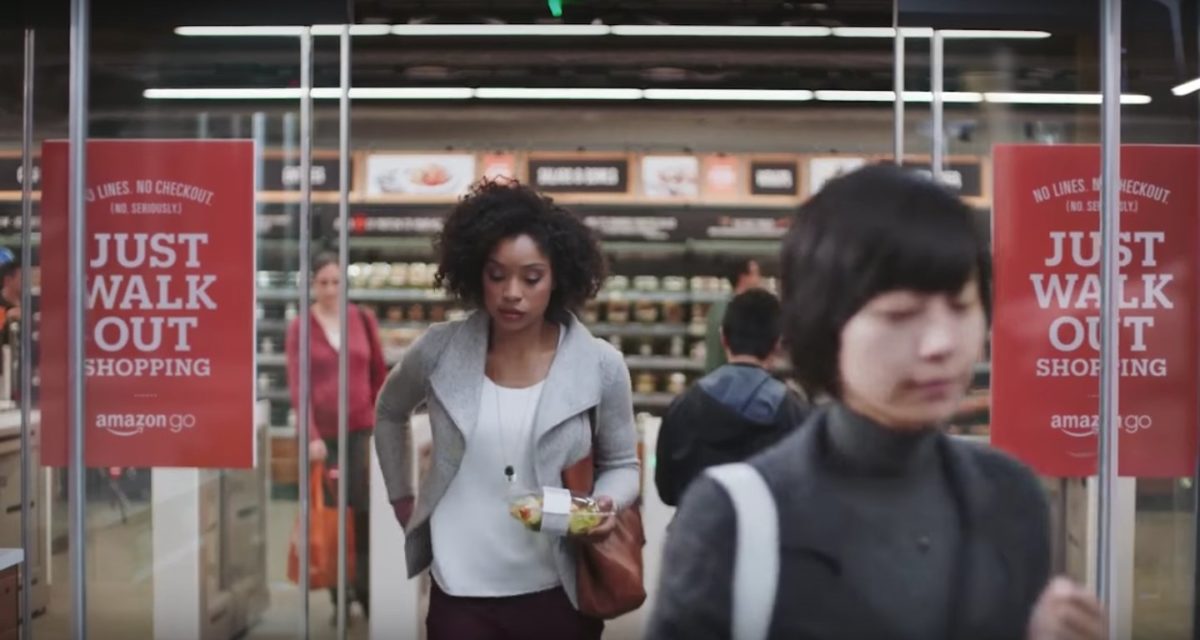Getting tired of lining up for your items to be scanned? Well you aren’t alone. Good news is, some of the people like you got it already all figured out. Meet the supermarket of the future: you will walk in, grab a bag of chips, and walk out – without being stopped for theft. How it works is a little bit more complicated however. With the use of AI, cameras will follow your every step, analyze what item you picked up from the shelves and put in your bag. As you walk out, the system automatically deducts the amount from your bank account.
Initiatives like Amazon Go or Alibaba’s Tao Cafe have already successfully tried this system1. For example, you only need to download the Amazon App before walking in a store, and the sensors will do the rest. Contrary to Alibaba, Amazon doesn’t use facial recognition, but computer vision and sensor fusion technologies2. They analyze what items you picked from the shelves, by measuring weigh for example, and link them to your account. There are also a many start-ups working in that field, whose pilot results are being closely watch by all retail giants, such as Carrefour.
The system does have limitations. It is still run only through pilots and is constantly observed for improvements, as it still makes mistakes for now. Moreover, we do have to consider privacy issues. As different companies creating this kind of systems are using different processes, it is unclear to see a trend as how the system will link your identity to the products in your basket. For instance Alibaba uses facial recognition, and Amazon Go requires you to download its app, which also collects customer data. In both cases, governments will have to step in and design rules for this new technological advancement.
(1) https://syncedreview.com/2018/01/22/amazon-go-vs-alibaba-tao-cafe-staffless-shop-showdown/
(2) https://www.wired.co.uk/article/amazon-go-seattle-uk-store-how-does-work


Very interesting read. In my opinion, the use of AI, facial recognition and sensor technologies is going to be the next ‘big thing’ in the food industry, especially the retail element of the food industry will be affected by these technologies. As mentioned in the article, Amazon Go and Alibaba are already experimenting with these technologies and there is no doubt that in the coming years you will walk out the supermarket without having to self-scan our products or stand in queues at checkout counters. It is interesting to follow this development in the food industry and analyse how large incumbents are going to respond to the threat of disruptions caused by IT, since we know that it is only a matter of time until AI and machine learning become a reality in the food industry (Bennett, 2018).
Pilots of start-ups in this field are already being watched by large incumbents. Start-ups are known for their agility and innovate character, but incumbents have deep pockets and a large customer base. It is the question whether it is wise to start experimenting with computer vision, AI, robotics or sensor technologies as a large incumbent or watch other start-ups pilot these technologies in the food industry and acquire them at a later point in time. The future will tell which supermarket chain is able to sustain their competitive advantage and what actions incumbents will take in order to retain their market share.
Bennett, M. (2018, March 29). Food Manufacturing And AI: Opening New Doors. Retrieved from Manufactering.net: https://www.manufacturing.net/article/2018/03/food-manufacturing-and-ai-opening-new-doors
Interesting post! I recently noted that Albert Heijn also starts up something similar, namely that customers are able to scan products themselves using a handheld device or even their own mobile phone. Made me wonder though… how can this be still profitable for a supermarket? Firstly, developing this system is quite a big investment. Then, normally, a couple of 16-year old boys and girls operate the registers, while now the customer can scan all products and pay themselves. The problem I see though is that it is way more interesting to ‘not pay a certain product’. You simply put it in your basked undetected or don’t scan it on your app. Does replacing a couple of 16-year olds (with a relatively low salary per hour) really save money compared to the fact that people might now be more inclined to not pay for something – including the initial development cost of the system. Same goes for using AI, in the end, there will be a workaround available, right? What do you think?